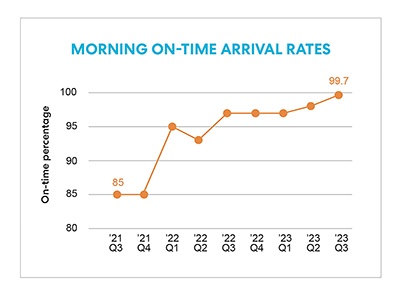
Presented by HopSkipDrive
Photos courtesy of HopSkipDrive
Ongoing, real-time assessment of students’ needs is critical to implementing innovative solutions that can make meaningful reductions in chronic absenteeism.
Chronic absenteeism has become one of the largest barriers to academic success for children in the United States. In fact, since the pandemic began, research shows that the number of public school students who miss at least 10 percent of days in a school year has nearly doubled.
While chronic absenteeism is concerning at face value — a lack of attendance can cause students to fall behind academically, fail classes, or even drop out altogether — there are other, less perceptible impacts too. For example, when children don’t attend school consistently, they also miss out on crucial social interactions and other types of support, which oftentimes accentuates the inequity facing our most vulnerable students.
There are many factors that contribute to chronic absenteeism, but the lack of diverse and holistic transportation options that meet students where they are — geographically, physically, and emotionally — is one of the biggest contributors. Across the country, parents and student caregivers are more frequently choosing options such as private and charter schools, magnets, and other non-traditional schools. School districts are being tasked with keeping up (often on a daily basis) with the changing individualized transportation needs of all students who reside in their school zones, including youth living in foster care or experiencing homelessness and children with disabilities.
Given all of these considerations and more, the simple fact is: School transportation teams are in a critical position to help solve this crisis. School transportation teams need more options to supplement the yellow school bus, therefore ensuring there are more tools to get kids where they need to be when they need to be there. The yellow school bus serves many needs well, but this iconic facet of our educational system is facing unprecedented driver shortages along with numerous other societal and economic pressures that are making it difficult, if not impossible, for this singular form of transportation to help schools meet the needs of all students.
An expansion of transportation options to and from school can help remedy growing chronic absenteeism numbers by ensuring that every student has the means to attend school every day regardless of their geographic location, individual needs, or socio-economic status.
Many schools have attempted to utilize traditional methods of addressing operational challenges by consolidating, combining or extending yellow school bus routes; changing school bell times; altering class schedules; underwriting the use of public transportation; or encouraging and incentivizing parent/caregiver drop-offs. But school transportation teams can and should think differently about the challenge of reducing chronic absenteeism.
How transportation teams can make a difference
School transportation teams are essential allies in combating chronic absenteeism. Given their unique vantage point, transportation staff have the ability to identify and understand the barriers students face in accessing education on a day-to-day basis. Transportation teams interact directly with students and families, giving them access to crucial insights about the diverse circumstances that impact attendance.
Whether revising routes to reach students in underserved areas, accommodating students with disabilities, or addressing the needs of students who are being moved from place to place (such as students experiencing homelessness or in foster care), transportation teams are on the front lines, bearing witness to the complexities of student transportation needs firsthand.
This ongoing, real-time assessment of students’ needs means that transportation teams have localized expertise and knowledge that is critical to identifying and implementing innovative solutions that can address the challenges at hand. Utilizing this on-the-ground analysis to assess the unique needs of students, transportation teams can expand available resources by exploring innovative transportation options that leverage technology to improve communication and accessibility.
Outlining potential solutions to help address chronic absenteeism
Strategies for improving chronic absenteeism are often not holistic in nature. Many fail to offer the reliability, safety, accessibility, and efficiency needed to truly solve the issue. To make strides in correcting chronic absenteeism, solutions offered must be:
• Safe: When the school bus is not an option for students, they are often left to try to arrange rides on their own, rely on public transportation, or walk through unsafe neighborhoods. The result of these options: Students often just don’t attend school at all. Issues like this that impact a student’s safety or health while traveling to school can have an adverse effect on attendance and overall academic performance.
• Reliable: According to a study in Baltimore, reliance on public transit often lengthens or complicates commute routes for students, making them more likely to miss more days in high school than they did in middle school. While encouraging students to utilize public transportation as a means of attending school is well intended, public transit is often not dependable enough to serve as an effective solution to the issue at hand.
• Efficient: A recent study concluded that students with longer commute times miss school one more day a year than students with shorter commutes. Another analysis of bus-riding students found that absenteeism was worse for students with 45-minute commutes compared to students with shorter commutes. In addition to contributing to chronic absenteeism, long commute times negatively impact students in other ways. Studies show that students who travel longer distances to get to school get less sleep and exercise, and have less time to engage in academic and extracurricular activities.
• Accessible to populations with diverse needs: Varying transportation options are necessary to enable students to access the education they deserve as soon as possible — including higher-quality schools that might have been previously inaccessible — and to allow for participation in enriching before- and after-school activities. Transportation solutions also must cater to the needs of the most vulnerable, including students experiencing homelessness and foster youth.
While finding safe, accessible, efficient, and reliable transportation to and from school for each and every student every day can likely feel like an insurmountable task at times for school transportation staff, there are a few different strategies transportation teams can use to help make progress on solutions.
Using data
Traditionally, states and districts have gathered and released rates of chronic absence after the school year has ended. While this data can be helpful for retrospective analysis, it does not include real-time data, which can be crucial to solving chronic absenteeism as it unfolds.
However, some states — like California, Missouri, Nevada, and others — recently released chronic absenteeism data as part of yearly education dashboard data reports, which can help transportation teams gain a deeper understanding of the specific challenges faced by at-risk students so they can tailor transportation solutions accordingly.
Regular needs assessments as a form of data collection can also be helpful in identifying specific transportation challenges students are facing. This may involve surveying students, parents, and community members to gather insights into specific and relevant transportation needs and preferences.
Transportation teams can use this type of data — or even better, data gained from their district’s own attendance records — to combat chronic absenteeism as it occurs by noticing patterns in a lack of attendance, figuring out potential causes, and implementing targeted interventions. This kind of data can be useful not only internally at a district or school level but also when working in tandem with vendors and supplemental transportation service providers to address a variety of issues such as bus driver shortages, lengthy commute times, on-time arrivals, and, of course, attendance.
Riverside County Office of Education (RCOE) in California was inspired to partner with HopSkipDrive in an effort to remove transportation barriers and promote regular school attendance for at-risk students. RCOE’s partnership with HopSkipDrive led to a significant improvement in attendance rates — from 29% to 78% — for students living in foster care enrolled in RCOE’s Alternative Education Community School Program, demonstrating the effectiveness of such targeted interventions.

Riverside County Office of Education’s strategic partnership with HopSkipDrive led to a surge in attendance for students living in foster care.
Employing a mix of transportation options
School transportation has often utilized a one-size-fits-all approach, but this approach — combined with other factors — has begun to falter. Transportation teams must recognize and address the fact that many students have unique transportation needs that may require customization and flexibility in service offerings.

The results of a strategic partnership between Colorado Springs School District 11 and HopSkipDrive: consolidated and optimized bus routes, elimination of a driver shortage, a reduced carbon footprint, identified opportunities to reduce the district’s transportation capital budget by 40% over 10 years, and an increase in on-time bus and vehicle arrival rates from 85% to 99%.
For children with disabilities — a student population that is 1.5 times more likely to be chronically absent than students without special needs — traditional school buses may not always be the most appropriate or accessible option.
Students experiencing homelessness or in foster care also face unique challenges that can significantly impact their attendance. These students often lack stable living situations, making it difficult to predict their transportation needs from day to day. Their placement or home location can change frequently, and traditional transportation systems are often not equipped to accommodate last-minute changes or unpredictable schedules. This can, and all too often does, result in missed school days for these students, further exacerbating their educational disadvantage.
Transportation staff are in a unique, powerful, and meaningful position to help to keep track of these students to make sure they can easily and quickly get to and from school — no matter their circumstances or location. Dedicated support staff can also coordinate transportation arrangements for these students with supplemental transportation providers, rideshare programs, or community shuttles. These options offer greater flexibility in terms of scheduling and routing, allowing for the accommodation of individual student requirements. By diversifying transportation options and leveraging technology, transportation teams can ensure that every student has access to safe and consistent transportation service that works for them.
Advocating for technology and innovation
Integrating technology — such as mobile apps or online platforms — into transportation operations can improve communication, streamline transportation requests, and provide real-time visibility into bus routes and ride status, enhancing the overall transportation experience for students and families.
Integrating technology into transportation operations can also improve safety. Modern technology — including mobile telematics, GPS tracking, and even artificial intelligence — provides quick and easy access to all different kinds of information, including key performance indicators like driving behavior, impairment, and vehicle operations. By enabling transportation teams to track and respond to things like route deviations or driving patterns as they happen, technology can provide an unprecedented level of insight and intervention.
Technology was a key part of a strategic, and very successful, partnership between Colorado Springs School District 11 (D11) and HopSkipDrive. The HopSkipDrive team collaborated with D11 to understand the district’s unique needs, priorities, and procedures. Utilizing AI-powered machine learning, HopSkipDrive’s RouteWise AI™ then offered customized, data-driven routing plans tailored to D11’s specific requirements, priorities, and constraints. Equipping the district’s transportation team with data-driven options to input into routing software, RouteWise AI enabled the team to leverage local insights to customize the plan.

D11 was able to increase on-time bus and vehicle arrival rates, recovering over 17,000 hours for D11 students in the classroom. Learn more here.
Partnering with community organizations
For academic districts that have limited budgets for considering additional or supplemental transportation options, teaming up with community organizations and local agencies can help. By joining forces, transportation teams can help one another access additional resources and support to address transportation-related barriers to school attendance, such as providing transportation vouchers or coordinating transportation assistance programs.
Conducting outreach and engagement
Transportation teams can also approach the issue of attendance by initiating proactive outreach, such as home visits or identifying roles within the transportation office that are specifically devoted to attendance. Conducting outreach helps transportation teams establish effective communication channels with students, caregivers, and other important stakeholders to address any transportation-related issues promptly. This may involve providing contact information for reporting delays, changes in routes, or other related concerns.
Building positive relationships directly with riders, parents, and caregivers can not only help identify potential attendance barriers but it can also open the door to collaborative efforts to address them. Studies show that schools with higher levels of family engagement had significantly lower increases in chronic absence during the pandemic.
Advocating for policy changes
Policy changes at the local, state, and federal levels to address transportation-related barriers to school attendance are crucial. Transportation teams should push for increased funding for transportation services to improve transportation infrastructure and accessibility. Numerous states have been pursuing public policy proposals aimed at reducing absenteeism, and it’s critical that transportation is viewed as a cornerstone of the discussion.
Understanding the causes of chronic absenteeism
While there are a multitude of factors that can impact a child’s ability to attend school, research shows that persistent barriers to accessible, safe, and reliable transportation are one of the leading causes.
This issue is particularly relevant in our most vulnerable communities. For families with less socioeconomic privilege, children are often unable to get to their school of choice or don’t have a caregiver who can drive them to and from school — an issue that 30% of parents with economic insecurities face. According to research, 8.3% of American households did not have access to a working vehicle in 2022, which means that children in these families had limited options for getting to school in comparison to some of their peers.
Other relevant factors that impact attendance rates include the differences in easy access to transportation in rural vs urban areas, difficulty arranging transportation for highly mobile students facing housing insecurity, and a mismatch between the school bus as a mode of transport and a student’s individual needs.
In addition, bus driver shortages, undependable transportation, and reliance on lengthy public transit can all contribute to chronic absenteeism. Having a more diverse set of transportation options to work with can improve student attendance by reducing commute times and providing a safe, reliable, and accessible way to reach school, no matter a child’s unique situation.
Understanding the costs of chronic absenteeism
According to recent data gathered from 40 states and Washington, D.C., roughly 26% of students were chronically absent during the 2022–2023 school year — which represents a 15% increase from before the pandemic. While it’s common for students to miss school due to unforeseen illness or other extenuating circumstances, experts acknowledge that the rise in lack of attendance from grade school through high school has become alarming — even drawing the attention of U.S. government leaders.
Most obviously, chronic absenteeism negatively impacts academic outcomes, taking a toll on grades and standardized test scores. Chronic absenteeism as early as kindergarten is even a predictor of the likelihood of a student dropping out of school. For young, elementary-aged children in grades K–12 whose learning milestones are crucial for the rest of their development, negative academic performance can impede a child’s ability to master some of the most fundamental basics. In fact, a 2023 study based on fourth-graders found that absenteeism accounted for 27% of declines in test scores for math and 45% for reading. Among eighth-graders, the report attributed 16% of the drop in math and 36% of the drop in reading scores to absenteeism, too. What’s perhaps even more distressing is the long-term impacts of this absenteeism: An inability to reach specific academic milestones has been linked to poor labor market prospects, diminished health, and increased involvement in the criminal justice system.
Beyond academic performance, our educational institutions provide students with other types of support, the effects of which cannot be measured by standardized tests. Schools often provide vulnerable students with access to free meals, mental and physical health support, a social network of peers and trusted adults, and more. These school-based programs, when designed well, serve to help our most vulnerable students survive and thrive.
While chronic absenteeism impacts students across race, gender, socioeconomic status, and more, studies find that the impacts of chronic absenteeism are even more of a threat to people of color, as well as those who are economically disadvantaged. In 2022, 16% of Asian students and 24% of white students were chronically absent, compared to 36% of Hispanic students and 39% of Black students, only serving to widen the gap in access to education. Improving school transportation access for families of color can translate into better attendance and academic engagement, leading to improved educational outcomes.
While much has been done to address chronic absenteeism and offset the far-reaching impacts that can follow a child into adulthood, efforts have yet to close the widening gap. Some research even suggests that schools won’t recover from chronic absenteeism until at least 2030.
Given how monumental the issue of chronic absenteeism is, it can be easy to overlook some of the most fundamental agents of change, often right within our school systems: staff members who are on the ground with students every day in their communities and have firsthand knowledge of their struggles.
Transportation teams are pivotal
Chronic absenteeism is an ongoing threat to our children’s overall success and well-being — both academically and beyond. While there is no easy fix to this very complicated issue, transportation teams within our academic institutions are uniquely positioned to help advocate for, and initiate, innovative approaches and solutions.
By recognizing transportation teams as essential allies in the fight against chronic absenteeism, schools and communities can harness their expertise, creativity, and commitment to meeting the needs of students. From advocating for the adoption of a multifaceted approach that incorporates flexible transportation solutions to leveraging technology and innovation, transportation teams can play a pivotal role in addressing chronic absenteeism to help ensure that all students have equitable access to the education they deserve.
HopSkipDrive is modernizing school transportation to meet the needs of kids, families, schools, and communities. Contact us to learn more about how we work with schools and districts to help them solve complex transportation challenges. Visit hopskipdrive.com for more information.


